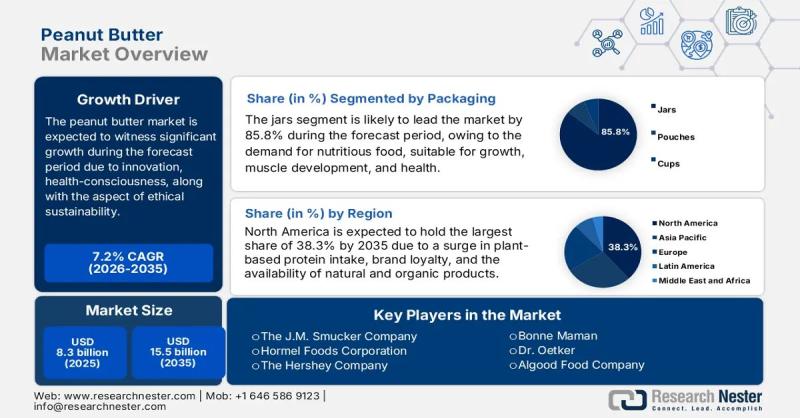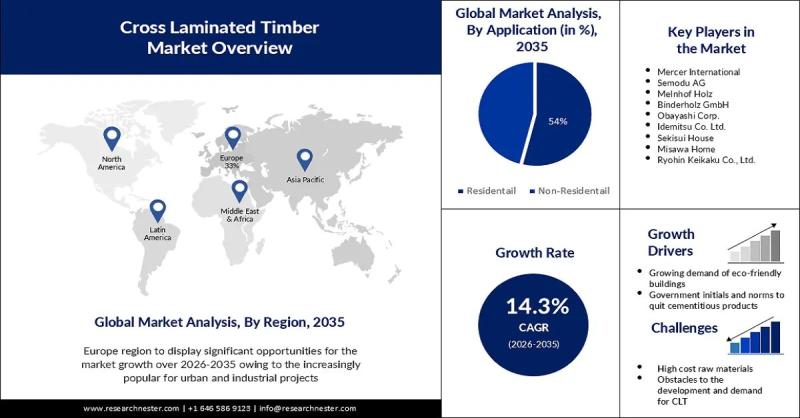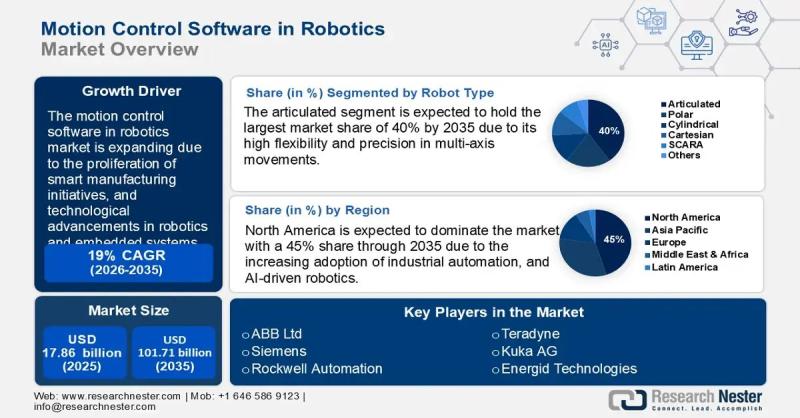Press release
Motion Control Software in Robotics Market Size: Strong Growth Projected Through 2035
The motion control software in robotics market is rapidly expanding as industries across manufacturing, logistics, healthcare, and defense embrace automation to achieve higher efficiency, precision, and scalability. In 2025, the market is expected to reach USD 17.86 billion, with projections indicating it will grow to USD 101.71 billion by 2035, reflecting a strong 19% CAGR from 2026 to 2035.Motion control software plays a critical role in modern robotics by enabling robots to execute complex movements with precision, speed, and adaptability. From autonomous mobile robots (AMRs) navigating warehouses to robotic arms assembling electronic components, motion control algorithms define how machines move, react, and interact with their environments. This technology is essential for synchronizing actuators, sensors, and controllers - ensuring that robotic systems function efficiently in dynamic industrial settings.
The adoption of motion control software is also being driven by the increasing sophistication of AI-based motion planning, machine vision, and predictive maintenance algorithms. As factories evolve into smart, interconnected ecosystems, robotics software is becoming the backbone of Industry 4.0, enabling seamless coordination between machines, humans, and digital platforms. Moreover, the rise of collaborative robots (cobots) that work safely alongside humans is boosting demand for adaptive motion control solutions that can respond to changing environments in real time.
➤ Request Free Sample PDF Report @ https://www.researchnester.com/sample-request-7566
Regional Performance Highlights
The Motion Control Software in Robotics Market demonstrates strong geographic diversity, with varying growth dynamics across key regions.
North America is projected to capture a dominant 45% revenue share by 2035, supported by advanced automation infrastructure, high R&D investments, and widespread adoption of robotics in industries such as automotive, aerospace, and healthcare. The U.S. and Canada are leading in developing autonomous systems and smart factories, driven by initiatives that promote digital manufacturing and industrial AI integration. The presence of major robotics software companies and research institutions further strengthens the region's leadership position.
Europe follows as a vital player, with countries such as Germany, the U.K., and France driving robotics innovation through their focus on smart industrial automation and sustainable manufacturing practices. European robotics companies are integrating motion control software with edge computing and AI to enhance operational flexibility and reduce energy consumption. The European Union's emphasis on human-robot collaboration and safety standards is shaping the evolution of next-generation control architectures.
Asia Pacific is expected to hold a significant share from 2026 to 2035, underpinned by its massive manufacturing ecosystem, rapid industrial digitalization, and government-backed automation initiatives. China, Japan, and South Korea are investing heavily in robotics R&D and adopting motion control technologies in automotive production, electronics assembly, and logistics automation. The region's expanding semiconductor and electronics sectors are further propelling the need for precise motion control systems.
➤ Gain access to expanded insights on competitive strategies, market size, and regional analysis. View our Motion Control Software in Robotics Market Report Overview here:
https://www.researchnester.com/reports/motion-control-software-in-robotics-market/7566
Segmental Insights
The Motion Control Software in Robotics Market is segmented by robot type, application, and end-use industry, each contributing uniquely to global market growth.
The articulated robot segment is projected to hold around 40% of the market share by 2035, reflecting its dominance across industrial automation applications. Articulated robots are widely used for welding, material handling, painting, and assembly operations due to their flexibility, range of motion, and precision. Motion control software in these systems enhances accuracy through advanced kinematic algorithms and sensor integration, enabling optimized path planning and collision avoidance.
The manipulation segment, accounting for 52% share by 2035, is emerging as a crucial domain in robotics. Robots designed for manipulation tasks-such as picking, placing, and assembly-rely heavily on sophisticated motion control software to execute high-speed operations while maintaining accuracy. This segment's growth is further accelerated by rising demand in sectors like e-commerce, food processing, and pharmaceuticals, where robotic manipulation ensures efficiency and safety in repetitive tasks.
End-use industries such as automotive, electronics, logistics, and healthcare are witnessing a surge in automation deployments powered by motion control solutions. For instance, healthcare robots equipped with precision motion systems are assisting surgeons in complex procedures, while logistics robots use real-time motion planning to streamline warehouse operations.
➤ Discover how the Motion Control Software in Robotics Market is evolving globally - access your free sample report → https://www.researchnester.com/sample-request-7566
Top Market Trends
1. Integration of AI and Machine Learning in Motion Control
The fusion of artificial intelligence (AI) and machine learning (ML) with motion control software is redefining robotics capabilities. AI-powered control systems allow robots to learn from data, adapt to new tasks, and optimize movement trajectories autonomously. For example, machine learning algorithms enable dynamic motion adjustment in cobots, improving safety and efficiency in human-robot collaboration. Companies are increasingly integrating AI-driven predictive analytics to reduce downtime and enhance operational agility across manufacturing facilities.
2. Cloud Robotics and Edge Computing Revolution
The adoption of cloud-based and edge-enabled robotics platforms is revolutionizing motion control by providing real-time data processing and remote monitoring capabilities. Cloud robotics allows centralized control of distributed robotic systems, while edge computing enhances response times and security. This hybrid approach supports scalable automation in industries like logistics and agriculture. Recent innovations, such as edge AI motion control processors, are enabling decentralized intelligence - empowering robots to make autonomous decisions closer to the source of action.
3. Sustainability and Energy-Efficient Robotics
As sustainability becomes a central industrial priority, motion control software is evolving to minimize energy consumption and extend equipment lifespan. Modern algorithms optimize power distribution and regenerative braking in robotic actuators, improving energy efficiency by up to 30%. Manufacturers are focusing on eco-efficient motion control architectures that align with global carbon reduction goals. These advancements not only reduce operational costs but also support industries striving for green manufacturing certification.
➤ Stay ahead of the curve with the latest Motion Control Software in Robotics Market trends. Claim your sample report → https://www.researchnester.com/sample-request-7566
Recent Company Developments
The Motion Control Software in Robotics Market is seeing significant strategic activity as leading players focus on technological innovation, mergers, and ecosystem expansion to strengthen their competitive positions.
1. ABB Ltd. introduced new motion control solutions integrated with its RobotStudio software, enabling virtual commissioning and AI-based motion optimization for industrial robots.
2. Siemens AG expanded its TIA Portal ecosystem with advanced motion control modules that enhance real-time robot synchronization and automation flexibility in smart factories.
3. Fanuc Corporation launched its next-generation motion controller designed for collaborative robots, improving safety, path precision, and machine learning integration.
4. Rockwell Automation, Inc. acquired a robotics software startup to enhance its motion control portfolio and strengthen its digital transformation offerings for industrial automation clients.
5. Yaskawa Electric Corporation released AI-driven motion software for its Motoman robot line, focusing on predictive maintenance and adaptive path control for manufacturing operations.
These developments underscore the market's focus on software-defined automation, cross-platform compatibility, and human-machine collaboration. Major players are investing heavily in cloud-based motion ecosystems and open-source frameworks to accelerate innovation and expand accessibility for developers and end-users alike.
➤ Request Free Sample PDF Report @ https://www.researchnester.com/sample-request-7566
➤ Related News -
https://www.linkedin.com/pulse/what-future-software-defined-perimeter-market-pzudf/
https://www.linkedin.com/pulse/how-enterprise-performance-management-shaping-r8glf/
Contact Data
AJ Daniel
Corporate Sales, USA
Research Nester
77 Water Street 8th Floor, New York, 10005
Email: info@researchnester.com
USA Phone: +1 646 586 9123
Europe Phone: +44 203 608 5919
About Research Nester
Research Nester is a one-stop service provider with a client base in more than 50 countries, leading in strategic market research and consulting with an unbiased and unparalleled approach towards helping global industrial players, conglomerates and executives for their future investment while avoiding forthcoming uncertainties. With an out-of-the-box mindset to produce statistical and analytical market research reports, we provide strategic consulting so that our clients can make wise business decisions with clarity while strategizing and planning for their forthcoming needs and succeed in achieving their future endeavors. We believe every business can expand to its new horizon, provided a right guidance at a right time is available through strategic minds.
This release was published on openPR.
Permanent link to this press release:
Copy
Please set a link in the press area of your homepage to this press release on openPR. openPR disclaims liability for any content contained in this release.
You can edit or delete your press release Motion Control Software in Robotics Market Size: Strong Growth Projected Through 2035 here
News-ID: 4255211 • Views: …
More Releases from Research Nester Pvt Ltd

Peanut Butter Market Future Scope, Competitive Landscape, and Forecast 2035
Market Outlook and Forecast
The global peanut butter market is witnessing robust expansion, propelled by shifting consumer preferences toward plant-based proteins, convesnient snacking options, and nutrient-rich spreads. Valued at USD 8.3 billion in 2025, the market is projected to reach USD 15.5 billion by 2035, registering a compound annual growth rate (CAGR) of 7.2% during 2026-2035.
➤ Request Free Sample PDF Report @ https://www.researchnester.com/sample-request-2716
Regional Performance Highlights
North America remains the dominant regional market,…

Cross Laminated Timber Market Outlook, Key Developments, and Future Growth Scope …
Market Outlook and Forecast
The cross laminated timber (CLT) market is rapidly gaining momentum as sustainable construction materials become a central focus for developers, architects, and policymakers worldwide. As of 2025, the global cross laminated timber market size is estimated to be valued at USD 1.62 billion, and it is projected to reach USD 6.17 billion by 2035, expanding at a strong 14.3% CAGR from 2026 to 2035.
The robust growth of…

AI Platform Lending Market Trends, Competitive Landscape, and Forecast Report 20 …
Market Outlook and Forecast
The global AI platform lending market is experiencing a pivotal transformation, underpinned by the convergence of artificial intelligence (AI), machine learning (ML), cloud-native infrastructure and the evolving demands of the lending sector. According to recent research, the market was sized at approximately USD 109.73 billion in 2024 and is anticipated to reach roughly USD 2.01 trillion by 2037, representing a robust growth trajectory over the 2025-2037 period.…

Data Protection Market Size, Share, and Long-Term Growth Opportunities to 2037
Market Outlook and Forecast
The global Data Protection Market is undergoing a period of unprecedented expansion, driven by the exponential rise in digital transformation, data breaches, and compliance requirements across industries. Valued at USD 158.77 billion in 2024, the market is expected to reach a staggering USD 1.12 trillion by 2037, registering a compound annual growth rate (CAGR) of 16.2% between 2025 and 2037. This remarkable growth trajectory underscores the centrality…
More Releases for Motion
Flight Motion Simulator Market is Booming - Gaining Revolution in Eyes of Global …
Market Overview:
Flight motion simulators replicate the experience of flying an aircraft by simulating the motions and visuals that pilots would experience when in actual flight. They are useful training tools that allow pilots to practice aircraft handling, instrument flight, emergencies and other scenarios in a risk-free virtual environment.
Market Dynamics:
The growth of the flight motion simulator market is driven by rising defense budgets of major economies and the need for cost-effective…
Motion Capture System Market is Gaining Momentum with VICON Motion, Motion Analy …
HTF MI introduces new research on Motion Capture System covering the micro level of analysis by competitors and key business segments (2023-2029). The Motion Capture System explores a comprehensive study of various segments like opportunities, size, development, innovation, sales, and overall growth of major players. The research is carried out on primary and secondary statistics sources and it consists of both qualitative and quantitative detailing.
Some of the major key…
Motion Capture System Market Review: All Eyes on 2023 Outlook| VICON Motion, Mot …
HTF Market Intelligence published a new research publication on Motion Capture System Market Insights, to 2028" with 150+pages and enriched with self-explained Tables and charts in presentable format. In the Study you will find new evolving Trends, Drivers, Restraints, Opportunities generated by targeting market associated stakeholders. The growth of the Motion Capture System market was mainly driven by the increasing R&D spending across the world, however latest scenario and economic…
3D Motion Capture Market Is Booming Worldwide | VICON, Motion Analysis, OptiTrac …
A New Research on the Global 3D Motion Capture Market was conducted across a variety of industries in various regions to produce more than 150 page reports. This study is a perfect blend of qualitative and quantifiable information highlighting key market developments, industry and competitors' challenges in gap analysis and new opportunities and may be trending in the 3D Motion Capture market. Some are part of the coverage and are…
Motion Control Market 2018 Global Leaders Overview: Schneider Electric, Rockwell …
Market Research Future published a research report on “Motion Control Market Research Report- Forecast 2023” – Market Analysis, Scope, Stake, Progress, Trends and Forecast to 2023.
Global Motion Control Market – Overview
Upsurge in the demand for automation in various areas of daily life have pushed the development of the motion control market to new heights. Market reports linked to the semiconductors & electronics sector made available by Market Research Future along…
Passive Infrared Motion Sensor Market-Rising Demand For Motion Enabled Industria …
Passive infrared (PIR) motion sensors are electronic sensor devices that detect motion and the presence of an identity or object that is a infrared emitting source. Any object that exceeds the temperature of absolute zero emits heat at a wavelength of infrared lights. The sensors are enabled for identification of the variations in IR radiations when an object is colliding with the primary subject of infrared radiation detection. Benefits of…
